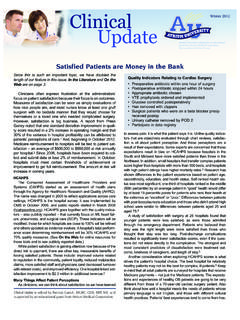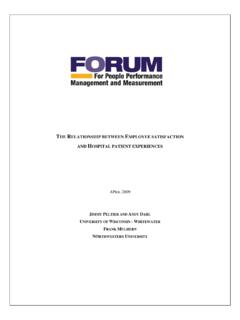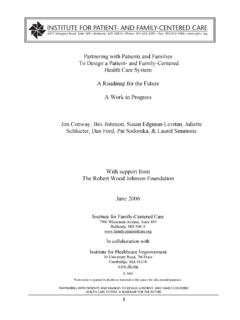Transcription of Communication Skills for Patient-Centered Care
1 THE JOURNAL OF BONE & JOINT SURGERY 87-A NUMBER 3 MARCH 2005 Communication Skills FOR Patient-Centered CAREC ommunication Skills for Patient-Centered CareRESEARCH-BASED, EASILY LEARNED TECHNIQUES FOR MEDICAL INTERVIEWS THAT BENEFIT ORTHOPAEDIC SURGEONS AND THEIR PATIENTSBY JOHN R. TONGUE, MD, HOWARD R. EPPS, MD, AND LAURA L. FORESE, MDAn Instructional Course Lecture, American Academy of Orthopaedic SurgeonsBetter physician-patient communi-cation is linked to increased patient satisfaction and patient adherence to medication and treatment regimens as well as to improved clinical outcomes1-4. Practicing orthopaedic surgeons have received limited formal education in the Communication Skills necessary for Patient-Centered care; yet, we perform over 100,000 medical interviews dur-ing our careers5. Patient-Centered care involves treating patients as partners, involving them in decision-making, and enlisting their sense of responsibil-ity for their care while respecting their individual values and concerns6,7.
2 We have tended to focus mainly on the technical aspects of our do not seem to be very good communicators9,10. In 1998, the Ameri-can Academy of Orthopaedic Surgeons (AAOS) conducted an extensive na-tional survey to which 807 patients and 700 orthopaedic surgeons responded11. The patients and surgeons were asked to rate orthopaedic surgeons with use of the same categories. patients rated technical Skills as important ( high-tech ) but valued Communication Skills equally ( high-touch )12 (Table I). Ac-cording to this survey, 75% of the or-thopaedic surgeons believed that they communicated satisfactorily with their patients , but only 21% of the ortho-paedic patients reported satisfactory Communication with their physicians. This gap was most evident in categories such as listening and caring and time spent with the patient9. Our most com-mon deficiency in our daily interviews with patients remains a failure to dem-onstrate an empathic can all learn to communicate better.
3 During the past twenty years, ef-fective tools for teaching and assessing physician Communication Skills have been developed. Communication Skills are being taught in medical schools and residency programs2,8,14-16. Beginning with the class of 2005, the United States Medical Licensing Examination will re-quire medical students to pass a clinical Skills -assessment examination by interviewing standardized patients at designated national testing centers17. Furthermore, the Accreditation Council for Graduate Medical Education and the American Board of Medical Spe-cialties now link assessment of com-munication Skills to accreditation of residency programs and to maintenance of certification for practicing physi-cians, respectively18,19. Busy orthopaedic surgeons must continue to build com-munication Skills to deal with the chal-lenges of shifting patient expectations, language and cultural barriers, increas-ingly complex medical treatments, and constraints from managed Communication Skills improve medical care and reduce lawsuits20.
4 Skillful interviews improve diagnostic accuracy by gathering a su-perior quantity and quality of data2. Physicians with adept Communication Skills establish rapport with their pa-tients and consequentially improve the patients compliance with treatment. Effective interviews also improve pa-tient outcomes, reduce medical errors, and make the specialty of orthopaedic surgery more enjoyable15,21, suits often are the re-sults of differences in expectations be-tween the patient and the physician. Beckman et al. reviewed depositions from sixty-seven malpractice claims and reported both the preponderance and the types of Communication problems described in these depositions23 (Table II). Good Communication helps physi-cians to understand patient expectations, thereby reducing liability Our Communication SkillsEducational ProgramsImproving Communication Skills , like improving operating Skills , is best done THE JOURNAL OF BONE & JOINT SURGERY 87-A NUMBER 3 MARCH 2005 Communication Skills FOR Patient-Centered CARE with an organized educational pro-gram.
5 Although written material is use-ful in improving patient-physician Communication , behavioral change is more likely to occur in a workshop9. The AAOS partnered with the Bayer In-stitute for Health Care Communica-tion (BIHCC) in 2001 to form the AAOS Communication Skills Mentors Program (CSMP)24. This initiative com-bines a successful educational model, the 4Es (engage, empathize, educate, enlist), with jointly developed ortho-paedic-specific video vignettes (Fig. 1). Twenty-five orthopaedic surgeons trained as mentors teach interactive workshops as part of the CSMP. Written comments and follow-up question-naires confirm the workshop partici-pant s interest and ability to successfully incorporate new Communication Skills Bayer educational model, or the 4Es, defines the critical communi-cation tasks to engage, empathize, ed-ucate, and enlist the patient which are considered to be of equal importance to the biomedical tasks, or the 2Fs, of finding the problem (diagnosis) and fixing the problem (treatment).
6 The BIHCC has fifteen years of experience teaching the science behind the art of medicine and has trained more than 90,000 clinician participants25-27. En-gagement establishes an interpersonal connection that sets the stage for the patient-physician interaction. Engage-ment draws the patient in. Empathy demonstrates the physician s under-standing of and concern about the pa-tient s thoughts and feelings. The patient is seen, heard, and understood by the physician. Education delivers in-formation to the patient. The patient learns something. Enlistment extends an offer to the patient to actively partic-ipate in decision-making. Enlistment acknowledges that the patient controls much of what can happen in his or her health-care treatment c h n i q u e s f o r Patient-Centered Interviews First impressions are important29,30. You should be neatly dressed and well groomed. You should clear your thoughts and smile to provide a pleas-ant introduction for the patient.
7 After knocking, enter the room with a deliber-ate but not rushed pace. Smile, make eye contact, and speak in a calm, pleasant, consistent tone of voice. All attention should be on the patient. When intro-ducing yourself, start with a salutation (good morning/afternoon/evening). The patient should be addressed as Mr., Ms., Madame, Se orita, etc. Check the pronunciation of the patient s name, if necessary. Even in an emergency, intro-ductions are should be cautious about asking patients How are you today? Although this is more of a greeting than a question in the United States, it can put ill or injured patients in the awk-ward position of responding that they are fine just before relating their story and/or medical problem. With the ini-tial introduction, say Welcome or Good to see you while maintaining eye contact and offering a handshake, when such a greeting is culturally ap-propriate. You should sit approxi-mately 2 to 4 ft ( to m) from the patient.
8 If the patient continues to look you over in an attempt to estimate your pace and the warmth of the initial greeting, you should try a normalizing statement such as How do you like this hot/cold/wet weather? You should not stand while the patient is seated during the medical : How can I help you today? Six simple, powerful words. Open-ended questions allow the patient the opportunity to define the conversation. Although it is hard to do, you should wait until the patient finishes speaking. It takes most patients two minutes to tell their story and explain why they are seeing you; however, the average physi-cian interrupts the patient within eigh-teen to twenty-three seconds. Avoid this pitfall. If you listen for two minutes the patient will tell you 80% of what you need to know2. Nodding, reflective fa-cial expressions, and continued eye contact all signal your attention to and concern for the patient. Physicians should look at the patient while listen-ing; notes should be written during pauses in the the patient says, for exam-ple, I m here because my shoulder hurts, you should respond by saying Fine, tell me all about it with an up-lifting, pleasant tone of voice indicating interest and concern.
9 If you say, Tell TABLE I Discrepancies Between AAOS Members Self-Assessment and patients Perceptions of Orthopaedic Care12 Physician s Perception: I Believe patients View Me As:Patient s PerceptionHighly trained70%64%Having successful results64%53%Being caring and compassionate71%37%Spending time with patients71%36%Providing valuable service65%35%TABLE II Contribution of Communication Breakdowns to Malpractice Risks*23 Patient mentioning poor relationship as reason for claim71% Patient felt deserted32%Patient felt devalued29%Patient felt information was delivered poorly26%Patient felt there was a lack of understanding by the clinician13%*The decision to litigate is most often associated with perceived lack of caring and/or col-laboration in health care delivery. THE JOURNAL OF BONE & JOINT SURGERY 87-A NUMBER 3 MARCH 2005 Communication Skills FOR Patient-Centered CAREme about your shoulder pain, you risk conveying the impression that you are interested only in a body part and that only that one complaint can be consid-ered.
10 Continue to avoid a transition to closed questions of what/how/when/where to gather more information. In-stead, the next few questions should flesh out the patient s story, not the in-terpretation of the orthopaedic condi-tion. Helpful statements might include I m curious about .. or Tell me more about .. A source of frustration frequently mentioned by participants during CSMP workshops is the unmentioned problem that arises at the end of the visit. These hidden agendas may force the physician to extend the visit and disrupt the schedule or risk angering the patient by leaving the problem unaddressed31. Because orthopaedic pa-tients often have multiple complaints, it is very important to identify them and, if necessary, to prioritize them ( Is there anything else? ). When secondary con-cerns cannot be adequately addressed during an office visit, the physician should explain in terms that are cen-tered on the patient s best interests ( We did not schedule enough time to adequately address these other prob-lems today, but we can schedule an-other appointment for you.)







